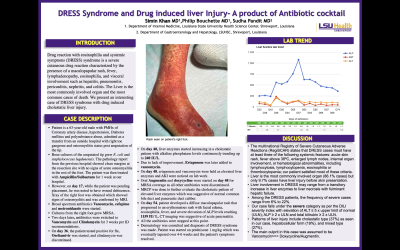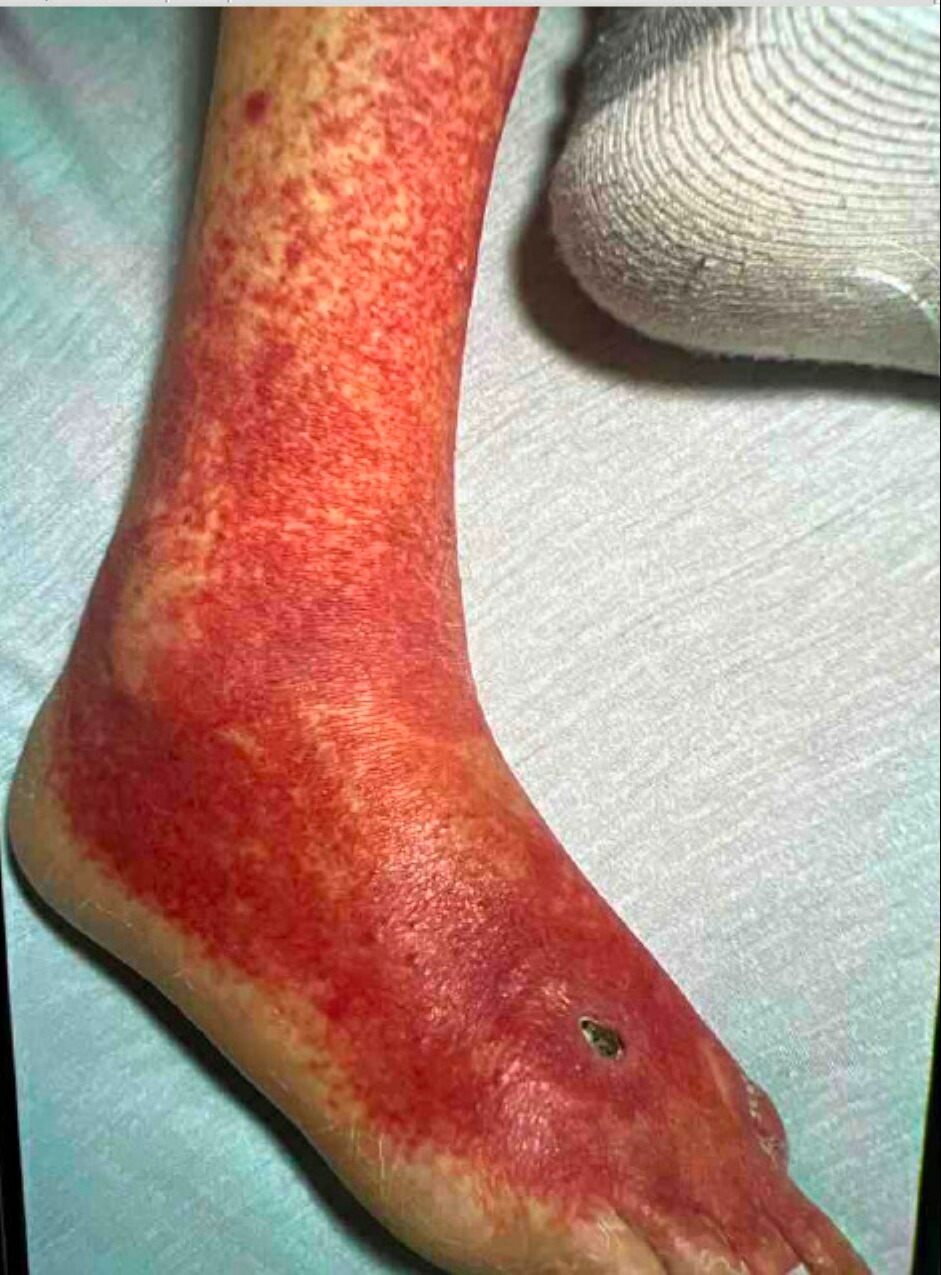Back


Poster Session E - Tuesday Afternoon
Category: Liver
E0519 - DRESS Syndrome and Drug-Induced Liver Injury: A Product of Antibiotic Cocktail
Tuesday, October 25, 2022
3:00 PM – 5:00 PM ET
Location: Crown Ballroom

Has Audio
.jpg)
Simin Khan, MD
Louisiana State University Health Sciences Center
Shreveport, LA
Presenting Author(s)
Simin Khan, MD1, Philip Bouchette, MD1, Sudha Pandit, MD2
1Louisiana State University Health Sciences Center, Shreveport, LA; 2LSUHSC, Shreveport, LA
Introduction: Drug reaction with eosinophilia and systemic symptoms (DRESS) syndrome is a severe cutaneous drug reaction characterized by the presence of a maculopapular rash, fever, lymphadenopathy, eosinophilia, and visceral involvement such as hepatitis, pneumonitis, pericarditis, nephritis, and colitis. The Liver is the most commonly involved organ and the most common cause of death.
Case Description/Methods: Patient is a 63-year-old male admitted with right toe gangrene status post amputation with cultures growing E. coli and staphylococcus lugdunensis treated with a prolonged course of multiple IV antibiotics. Patient was initially treated with Ampicillin/Sulbactum. On day 17, Xray of the foot was obtained & showed signs of osteomyelitis of the right foot. Antibiotics were switched to Vancomycin, cefepime and metronidazole. Shortly after, antibiotics were switched to Vancomycin and Clindamycin for better coverage. On day 36, the patient tested positive for flu, Tamiflu was started, and clindamycin was discontinued. Liver enzymes elevated in a cholestatic pattern with alkaline phosphatase levels continuously trending up. Ertapenem was later added to vancomycin. Eventually, ertapenem and vancomycin were held due to drug induced liver injury. Oral doxycycline and Augmentin were started on day 48. MRCP was negative and was suggestive of normal common bile duct and pancreatic duct dilation. Over the course of several days, patient developed a maculopapular rash with eosinophilia, fever, and severe elevation of ALP levels reaching 1159 IU/ L and 2 episodes of hematemesis. CT imaging was suggestive of acute pancreatitis. All antibiotics were stopped at this point. Patient underwent EGD which was not significant for any source of bleeding. Patient was started on prednisone 1 mg/kg which was eventually tapered over 4-6 weeks and the patient's symptoms resolved.
Discussion: Even though elevated ALP levels more commonly suggest obstructive jaundice, drug induced liver injury can also portray a cholestatic pattern of liver enzymes and should always be in the differential. DRESS syndrome is a unique diagnosis and recognition of the offending agent in a prolonged inpatient setting, and its withdrawal can halt the progression earlier in the disease course and prevent further organ damage.

Disclosures:
Simin Khan, MD1, Philip Bouchette, MD1, Sudha Pandit, MD2. E0519 - DRESS Syndrome and Drug-Induced Liver Injury: A Product of Antibiotic Cocktail, ACG 2022 Annual Scientific Meeting Abstracts. Charlotte, NC: American College of Gastroenterology.
1Louisiana State University Health Sciences Center, Shreveport, LA; 2LSUHSC, Shreveport, LA
Introduction: Drug reaction with eosinophilia and systemic symptoms (DRESS) syndrome is a severe cutaneous drug reaction characterized by the presence of a maculopapular rash, fever, lymphadenopathy, eosinophilia, and visceral involvement such as hepatitis, pneumonitis, pericarditis, nephritis, and colitis. The Liver is the most commonly involved organ and the most common cause of death.
Case Description/Methods: Patient is a 63-year-old male admitted with right toe gangrene status post amputation with cultures growing E. coli and staphylococcus lugdunensis treated with a prolonged course of multiple IV antibiotics. Patient was initially treated with Ampicillin/Sulbactum. On day 17, Xray of the foot was obtained & showed signs of osteomyelitis of the right foot. Antibiotics were switched to Vancomycin, cefepime and metronidazole. Shortly after, antibiotics were switched to Vancomycin and Clindamycin for better coverage. On day 36, the patient tested positive for flu, Tamiflu was started, and clindamycin was discontinued. Liver enzymes elevated in a cholestatic pattern with alkaline phosphatase levels continuously trending up. Ertapenem was later added to vancomycin. Eventually, ertapenem and vancomycin were held due to drug induced liver injury. Oral doxycycline and Augmentin were started on day 48. MRCP was negative and was suggestive of normal common bile duct and pancreatic duct dilation. Over the course of several days, patient developed a maculopapular rash with eosinophilia, fever, and severe elevation of ALP levels reaching 1159 IU/ L and 2 episodes of hematemesis. CT imaging was suggestive of acute pancreatitis. All antibiotics were stopped at this point. Patient underwent EGD which was not significant for any source of bleeding. Patient was started on prednisone 1 mg/kg which was eventually tapered over 4-6 weeks and the patient's symptoms resolved.
Discussion: Even though elevated ALP levels more commonly suggest obstructive jaundice, drug induced liver injury can also portray a cholestatic pattern of liver enzymes and should always be in the differential. DRESS syndrome is a unique diagnosis and recognition of the offending agent in a prolonged inpatient setting, and its withdrawal can halt the progression earlier in the disease course and prevent further organ damage.

Figure: Maculopapular rash seen on patient's right foot
Disclosures:
Simin Khan indicated no relevant financial relationships.
Philip Bouchette indicated no relevant financial relationships.
Sudha Pandit indicated no relevant financial relationships.
Simin Khan, MD1, Philip Bouchette, MD1, Sudha Pandit, MD2. E0519 - DRESS Syndrome and Drug-Induced Liver Injury: A Product of Antibiotic Cocktail, ACG 2022 Annual Scientific Meeting Abstracts. Charlotte, NC: American College of Gastroenterology.
